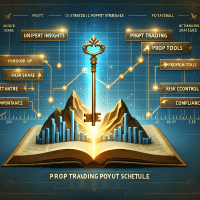Proven Prop Trading Partnership Strategies for Expert Traders
For prop traders and firm decision-makers alike, a successful prop trading partnership can be the key to scaling strategies, optimizing risk management, and leveraging advanced backtesting tools to refine trading algorithms. In this guide, we provide actionable insights into building and maintaining a profitable prop trading environment, comparing industry-leading tools and highlighting advanced backtesting techniques.
Why Prop Trading Partnerships Matter
Prop trading partnerships provide access to extensive capital, share risk, and foster collaboration between skilled traders and advanced analytics teams. With competitive payout structures and cutting-edge technology, these partnerships empower traders to refine their strategies without bearing full market exposure. Whether you are a junior trader, senior quant, or risk manager, understanding the nuances of these partnerships is crucial.
Figure 1: A comprehensive snapshot illustrating key metrics in a prop trading partnership, including trade performance and risk metrics.
Advanced Backtesting Techniques in Prop Trading
Backtesting is central to any prop trading strategy—ensuring that models perform under historical and out-of-sample scenarios is essential to avoid pitfalls such as overfitting or survivorship bias. In this section, we explore both advanced techniques and common pitfalls:
Common Pitfalls and Mitigation Strategies
- Overfitting: Incorporate walk-forward optimization to ensure your model adapts to new data structures.
- Look-Ahead Bias: Use strictly out-of-sample data when testing new strategies.
- Data Snooping: Employ robust statistical tests to validate parameter selection.
Walk-Forward Optimization vs. Traditional Backtesting
The walk-forward analysis method improves traditional backtesting by dividing historical data into iterative training and testing segments. This approach simulates real-market transitions and prepares models to adapt to dynamic conditions. Out-of-sample testing should complement these techniques to further enhance performance reliability.
Comparative Analysis of Leading Backtesting Tools
Prop trading firms rely on sophisticated backtesting platforms to optimize strategies quickly. Here, we compare popular choices to help you choose the right tool for your partnership:
| Tool | Backtesting Features | Data Quality & Availability | Integration Capabilities | Pricing & Use Case |
|---|---|---|---|---|
| TradingView | Event-driven, vectorized backtesting, real-time simulation | Deep historical data, covers multiple asset classes | API access, broker integration | Free basic plan with paid upgrades ideal for both retail and prop firms |
| MetaTrader 5 | Supports MQL5 code for automated backtesting, includes optimization and stress testing | Robust historical data of forex, stocks, futures and more | Direct broker integration, extensive community support | Free to use; mainly popular among forex traders and prop trading desks |
| NinjaTrader | Advanced trade simulation with commission/slippage settings, custom indicator testing | High-quality historical market data with real-time updates | API support, customizable dashboard | Licensing options available; suitable for advanced team collaboration at prop firms |
Such comparisons emphasize the importance of selecting a tool that meets both retail and institutional requirements, ensuring scalability, real-time testing, and automation across various trading strategies.
Integrating Automated Backtesting with Live Trading
One of the most significant breakthroughs in prop trading has been the integration of automated backtesting results into paper trading and live trading phases. Here are some critical components:
Automating Parameter Optimization and Report Generation
Modern platforms like QuantConnect not only allow for backtesting, but also enable automated parameter sweeps, generating detailed performance reports. These reports include the Sharpe ratio, maximum drawdown, profit factor, and stress test outcomes. For example, a Python snippet using Backtrader might look like this:
import backtrader as bt
class TestStrategy(bt.Strategy):
def next(self):
if not self.position:
if self.data.close[0] > self.data.open[0]:
self.buy()
else:
if self.data.close[0] < self.data.open[0]:
self.sell()
cerebro = bt.Cerebro()
cerebro.addstrategy(TestStrategy)
data = bt.feeds.YahooFinanceData(dataname='AAPL', fromdate=datetime(2020,1,1), todate=datetime(2020,12,31))
cerebro.adddata(data)
results = cerebro.run()
print('Sharpe Ratio:', calculate_sharpe(results))
Risk Management and Forward Testing Integration
Before deploying a new strategy live, traders should integrate paper trading to monitor risk metrics, including drawdown levels and volatility adjustments. Prop firms often implement risk thresholds aligned with regulatory standards such as MiFID II. A robust risk management checklist is key:
- Set maximum drawdown limits (e.g., 10-15% per strategy)
- Define stop-loss thresholds based on volatility trends
- Continuously backtest against new data to validate performance
Figure 2: Visualizing advanced backtesting reports – essential for refining strategies and ensuring compliance with risk management standards.
Real-World Case Study: Success in a Prop Trading Partnership
An established proprietary trading firm recently adopted a multi-tiered strategy combining automated backtesting with real-time paper trading. The firm utilized platforms like NinjaTrader and TradingView to test diverse strategies including trend-following and mean reversion. Key challenges included:
- Data Quality: Adjusting for missing tick data and accurately simulating slippage
- Strategy Robustness: Mitigating overfitting through walk-forward optimization and out-of-sample validation
- Risk Compliance: Conforming to regulatory standards while maintaining scalability
By integrating automated parameter optimization and detailed performance reports, the firm achieved a 20% improvement in its Sharpe ratio and reduced maximum drawdown by 15% over six months. This approach not only bolstered their risk management framework but also enabled faster iteration cycles, allowing quicker adjustments in a fast-paced market environment.
Practical Tips for Enhancing Your Prop Trading Partnership
To maximize the benefits of a prop trading partnership, consider the following advanced strategies:
Implementing a Comprehensive Risk Management Checklist
A robust checklist should include:
- Clear definitions of risk limits for each strategy
- Regular audits of historical performance reports
- Automated alerts for breaches in drawdown or volatility thresholds
Pro Tip: Ensure that each team member, from junior traders to senior risk managers, is trained on the checklist to maintain consistency in strategy evaluation.
Enhancing Strategy Development Through Tool Integration
Link your backtesting results with real-time trading dashboards for seamless performance monitoring. Tools such as MetaTrader 5 offer integrated environments where strategy signals can be generated and immediately tested using live data feeds. Furthermore, platforms like NinjaTrader provide extensive API support for customization.
Regulatory Considerations in Prop Trading
Regulatory frameworks such as MiFID II, ESMA guidelines, and NFA rules play a significant role in shaping prop trading operations. Firms must adhere to:
- Capital Adequacy: Ensuring sufficient capital buffers to absorb unexpected losses
- Transparency in Trade Execution: Clear audit trails and reporting mechanisms
- Compliance with Data Regulations: Maintaining integrity of historical and real-time data
Staying updated with such regulations not only prevents legal complications but also contributes to an enhanced risk management environment.
Next Steps: Advancing Your Prop Trading Journey
For traders and prop trading firms ready to take the next step, consider these actionable resources:
- Download our Risk Management Checklist for detailed strategy evaluation.
- Join our upcoming webinar on Advanced Prop Trading Strategies for live demonstrations.
- Explore our guide on Effective Risk Management in Prop Trading for further insights.
By embracing these advanced backtesting practices and leveraging cutting-edge platforms, your prop trading partnership can attain higher efficiency, reduced risk, and notable performance improvements.
Industry Insight: As of






